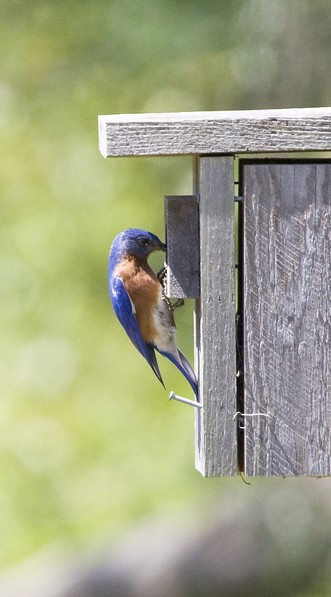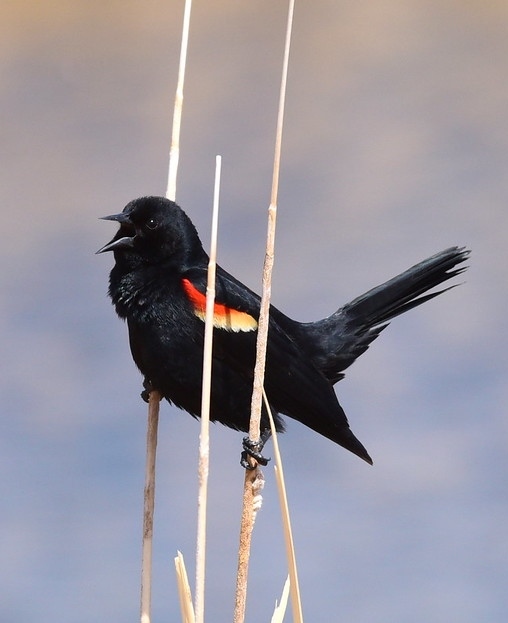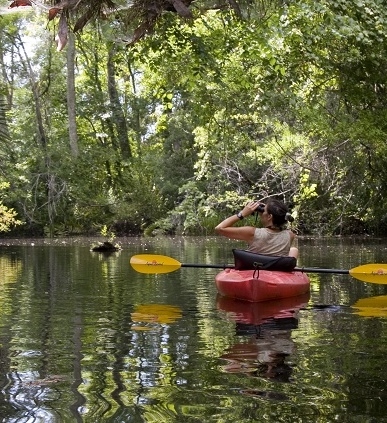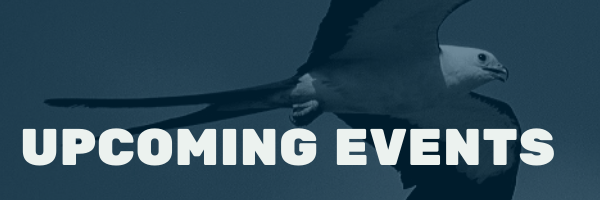 An Eastern Bluebird perched at the opening of a nest box, FWC photo
As we gear up for spring, many of us are putting out and sprucing up nest boxes in the hopes of attracting breeding birds to our yards. Watching the cycle of nest building, egg laying, parents feeding their young and fledglings leaving the nest is one of the season’s greatest pleasures.
Did you know that collecting information on birds nesting in your yard can provide valuable data for scientists to track trends in bird reproduction? NestWatch is a program organized by the Cornell Lab of Ornithology that allows anyone to become a citizen scientist! All you need to do is find a nest, visit every three to four days, and report what you find using the website or mobile app.
When monitoring a nest, it’s important to keep the safety of the birds in mind. To minimize disturbance, keep visits short, never handle eggs or birds, avoid visiting during the early days of incubation or in bad weather, and stay away when the young are close to fledging – you don’t want to scare them out of the nest too early. It is also important to keep in mind that predators may be watching – some clever nest thieves like blue jays or neighborhood cats might get curious about why you’re going to the same spot again and again, so try to be as sneaky as possible during your visits. Full information on how to be a responsible nest watcher is available on the NestWatch website and you will need to pass a quiz to become a certified nest watcher.
You can monitor nests anywhere – a local park that you frequent, your favorite place to hike or right in your own yard. The NestWatch site has information on how to attract birds to your yard and you can find detailed Florida-specific information in FWC’s Planting a Refuge for Wildlife booklet. Wherever you monitor, watching a family of birds grow from egg to fledgling is a very special experience that offers a new window into the lives of our feathered friends.
The data collected through this program has already led to a number of new discoveries – scientists have learned how factors like rising temperatures, drought, and light and noise pollution affect nesting and fledging success. Help fuel future breakthroughs by signing up today!
 A male Red-winged Blackbird singing in the reeds
You’ve probably noticed an uptick in birdsong as we barrel forward into March. The chorus of songs and calls makes for a beautiful soundtrack to any outdoor adventure but it can be hard to pick out who’s who in the symphonic composition.
Identifying birds by sound can be daunting, especially for beginning birders, but one way to make the learning curve a little less steep is to use mnemonic devices. These are fun phrases that sound a bit like bird calls and songs, and that are simple and easy to memorize. Here are some mnemonics that can help get you started.
Carolina Chickadee: “Chickadee-dee-dee”
Tufted Titmouse: “Peter peter peter”
Carolina Wren: “Tea kettle tea kettle tea kettle”
American Robin: “Cheerup, cheerily, cheerily”
Eastern Towhee: “Drink your teaaaaa”
Eastern Wood Pewee: “Pee-o-wee”
Red-headed Woodpecker: “Kweer, kweer”
Northern Parula Warbler: “Zeeeee-up”
Black-and-white Warbler: “Wheezy, wheezy, wheezy”
Northern Bobwhite: “Bob-white”
There are other tips and tricks you can use as well. Make sure to listen to cues, such as whether songs are ascending or descending in pitch, and listen for repeated elements. Northern Mockingbirds and Brown Thrashers, for example, have a wide repertoire of complicated phrases but thrashers always repeat each phrase twice while mockingbirds repeat three or more times. You can also find bird sounds online in the species profiles on Cornell’s All About Birds site.
As with any new skill, the best way to improve is to practice, practice practice – so hit the trail and keep your ears open!
 A kayaker birds while paddling along the Pithlachascotee River, FWC photo
Nearest city: New Port Richey
6938 Plathe Road, New Port Richey, 34653
Open: Daily, sunrise to sunset
Contact: 727-841-4560
Website
An unexpected treasure in the middle of New Port Richey, this preserve opened in 2003 and has a site checklist of more than 150 species. Visitors can hike the river or upland (scrub and sandhills) loop trails or paddle the Pithlachascotee River, which changes quickly from a wide waterway to a winding stream over-arched with vegetation. Bald Eagles and Short-tailed Hawks nest nearby and are often seen at the preserve. Look for Yellow-crowned Night-Herons, Wood Ducks and Limpkins along the water and songbirds, such as Cedar Waxwings and Blue-gray Gnatcatchers in the canopy. Neotropical migrants, such as Veeries, Swainson’s Thrushes, Chuck-will’s-widows, Tennessee Warblers and Scarlet Tanagers pass through in spring and fall. Barred and Eastern Screech-Owls are present all year; listen for their calls toward evening. Watch for gopher tortoises in the sandhills and scrub. Bobcats are spotted in the preserve on occasion, so be alert and keep your voices down to improve your odds of seeing these elusive and impressive felines. Park amenities include a canoe and kayak launch plus a .5-mile accessible boardwalk along the river and an observation deck. No pets are allowed at this preserve.

March 4 – Oystercatchers and Shorebirds: Wing and a Prayer (Virtual)
March 6 – Scrub-jay Trail Orientation (Clermont)
March 6 - Birding Trip to Withlacoochee Gulf Preserve (Yankeetown)
March 6 – Beginners’ Bird Watching Class (Christmas)
March 9 – Birding Trip to Honeymoon Island (Dunedin)
March 11 – Thursday Morning at the Matanzas Inlet (St. Augustine)
March 13 – BioBlitz Nature Walk (Clermont)
March 16 – Saving Florida (Virtual)
March 19 – Birds and Culture of Peru (Virtual)
March 20 – Birding and Biking on the Withlacoochee Trail (Brooksville)
March 20 – Nature Walk and Work Day: Crosby Sanctuary (Orange Park)
March 25 – Diversity in Florida Native Bees (Virtual)
March 26 – Beginning Birder Walk (Brooksville)
March 27 – Open House at Crosby Sanctuary (Orange Park)
Do you know about any other bird or wildlife related events going on in Florida? Help spread the word by letting us know! Send in the times, dates, locations and contacts to WildlifeViewing@MyFWC.com for posting on the Great Florida Birding and Wildlife Trail website.
Events must be related to birds or other wildlife and must be open to the public. Examples include field trips, interpretive programming, webinars, summer camps and family programs.
|